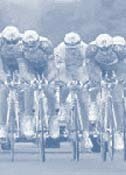|
 Welcome to all Touring and Racing cyclists Welcome to all Touring and Racing cyclists
In this substantial section we cover more of the advanced elements of cycling, without ignoring the basics.
This area therefore includes a substantial section explaining the various race disciplines and how to enter your first race.
We include information regarding cycle specific training and nutrition which is aimed at those starting racing or those that have been racing for many years.
We will also cover the major Tours and that information, if not within this section, will have a direct link to it.
An example of the section content.
When cycling you will invariably encounter a hill, or mountain, that must be ascended. If you are a racing cyclist, you will know this is often where races are won and lost.
For some the experience of riding up a hill will be one of elation but for most, the pain of climbing has been enough to see the bike sent to the darkest recesses of the shed or garage and the reintroduction of tiddly-winks to the daily activities.
The simplest way of improving your hill climbing is to incorporate hills in all or most of your rides. Avoiding hills will not improve your ability to climb them.
The experience of climbing hills shouldn't defeat anyone because through the use of proper technique, even the mountain pass will become a challenge rather than a dread.
If you decide to include hills in your training rides there are several variables to be considered when climbing
Gear Shifting
Do not down shift too soon as this will lose you valuable momentum. When this happens you end up having to work harder to regain your lost momentum and this puts your legs under unnecessary strain right from the outset.
Conversely, do not shift too late as this also will result in a waste of energy by pushing too large a gear.
The idea with gearing and shifting is to maintain a "comfortable cadence", shifting when you become uncomfortable and your rate of pedalling drops, but before you bog down and have to horse the gear.
Some top cyclists recommend a cadence of around 80 RPM and shifting up to a higher gear as you near the top. However others prefer climbing at a lower cadence, noting that the higher the cadence the more oxygen you will consume.
This was backed up by an article in "Medicine and Science in Sports and Exercise" that found that "maximum sustainable power to be greater at 60 RPM than at 100 RPM, and blood lactate responses to be greater at the higher RPMs".
|